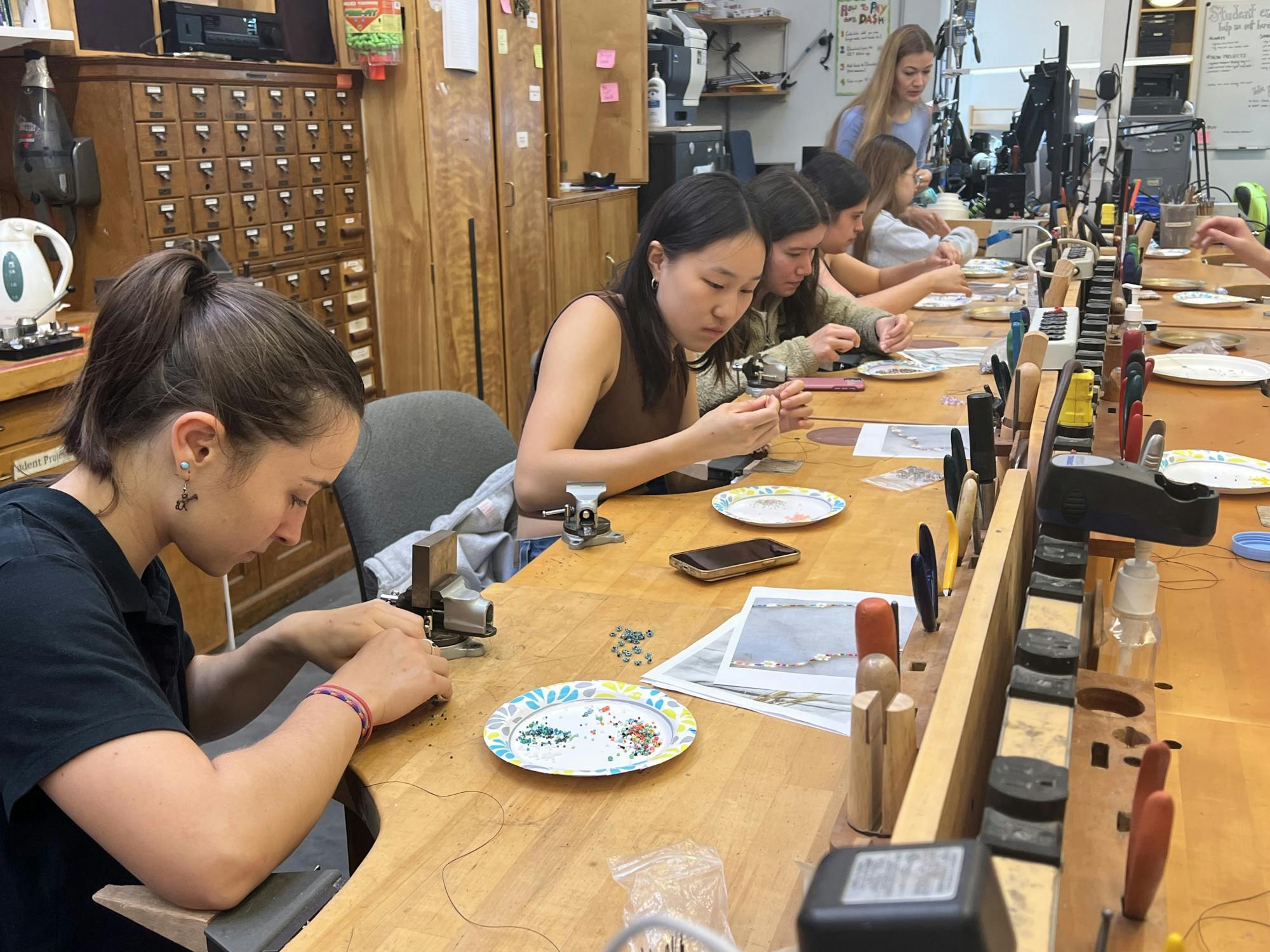The Donald Claflin Jewelry Studio — also known as the J-Shop — gives all students, regardless of their artistic backgrounds, the opportunity to exercise their creativity and craft wearable pieces of jewelry. Currently located in room 333 of the Black Family Visual Arts Center, the jewelry studio offers a wide variety of projects, using sophisticated — yet accessible — tools and techniques.
The J-Shop offers a space for students to work with their hands away from the screens, which dominate the day-to-day lives of many. In a way, however, studio director Jeffrey Georgantes said that the integration of technology into art often makes jewelry-making more accessible. Students often show up with inspiration from online sources, looking to imitate certain pieces.
“We have to be almost jewelry counselors,” Georgantes explained. “Sometimes people come in with something that they saw on the [Tiffany & Co.] website, for example, that costs $15,000. You have to be a master [to make it], and so we look at that [image], figure out how to, if possible, recreate something that approximates it for an absolute beginner. That part can be really challenging, but having done it so much, we’re pretty good at it.”
There are numerous projects geared towards beginners, as well as several other instructors on staff to give step by step instructions and support, according to student J-Shop employee Jasmine Li ’24.
“Honestly, just sign up and show up. We’re all trained in the beginner projects, and we have a display case with a lot of the beginner projects,” she said. “So people can come up with an idea of what they want to make. Or if they don’t have any idea and just want to show up, we’ll help them get started on whatever they want.”
Li highlighted the stamp ring as a common beginner project.
“It teaches a lot of the rudimentary skills that you need,” Li explained. “And from the stamp ring, you can build up to setting a stone, which is always fun. It’s just a little more complicated. So the stamp ring is nice because it gives a good baseline.”
Creating a stamp ring involves creating a band, and students can emboss words or symbols on it, according to Georgantes.
“In the process of making a ring, you have to take a piece of metal, cut it to a certain size so it’ll fit the finger, weld it together, give it some kind of texture,” Georgantes said.
Though it is a novice level project, it still allows students to exercise their creativity. “What people say on those rings is very much open for interpretation,” Georgantes said. “It could be something from poetry to latitude or longitude marks of their favorite place. Sometimes it’s cuss words. You know, you name it. And we make hundreds of those a year.”
Shannen Gallagher ’26 visited the J-Shop last spring as a total beginner and made a band ring herself.
“[The instructors] make it very hands-on for you,” Gallagher said. “They teach you what you’re doing, how to use the different tools. And I got to practice a bunch, try different stamps while learning the techniques.”
In addition to gaining the skills to create unique pieces of jewelry, Li added that she felt her experience in the jewelry studio has changed the way she looks at jewelry overall. Prior to going to the jewelry studio, she did not really think too much about the jewelry others wore or about the jewelry that different shops carried. Now that she knows how to make jewelry, though, her entire approach to jewelry has changed.
“It’s fun to look at jewelry that people are wearing, or go to stores and be like ‘Oh, I can figure out how that was made,’ or ‘I can reverse engineer the process,’” Li explained. “I’ve got a bookmarks folder on my computer that’s just like jewelry [inspiration], jewelry to make, jewelry to buy.”
Both Georgantes and Li emphasized the community aspect of the J-Shop. Georgantes began his time at the jewelry studio in 2005. Over his 19 years working with students in the studio, he has seen a shift in the way students express and pursue their creativity.
“Because so much creative experience is in the virtual universe, it makes what we do seem actually more exceptional,” Georgantes reflected. “So there’s a lot of people who crave to work with their hands.”
Georgantes has also found that working in the jewelry studio has given him the unique opportunity to bond with students over several years. Prior to being at Dartmouth, Georgantes taught as an art professor, working with a student for usually only a term. Now, at the jewelry studio, Georgantes explained that he has the potential to meet students at pre-orientation events and see them all the way to graduation, sometimes even for graduate school at Dartmouth.
“It’s profoundly interesting and fulfilling to meet folks fresh out of high school, in the earliest ages of being a young adult and work with them sometimes every day, if not every week, all the way up until they graduate, watching them turn into young adults,” he said. “It’s amazing. You witness that transformation.”
Li further discussed the community aspect of the J-Shop, emphasizing how the space has become a home on campus for her.
“The jewelry shop is my safe space on campus. If I don’t know where to go in between classes, or if I have an hour or two to kill, I’ll just pop in and hang out and make something,” she said. “One, it’s a great outlet. Two, it’s just a fun space to hang out, and everyone is so nice and welcoming.”




